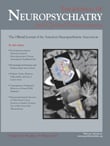Drs. Coburn, Lauterbach, Boutros, Black, Arciniegas, and Coffey Reply
To the Editor: We appreciate Dr. Coutin-Churchman’s interest in our paper and welcome the opportunity to address his comments. We did indeed refer to his paper as exemplifying many of the difficulties involved in building a clinically applicable qEEG system de novo, but we are unable to locate anywhere in our paper the quotation he attributes to us about “the more complex mathematics involved.” Furthermore, we do not state anywhere in our paper that he used “hypernormals” instead of “street normals” in his normative healthy database. Dr. Coutin-Churchman states that we neglected his observation that “there was a significant statistical trend for some patterns … to be more frequently observed in some disorders.…” However, the paper he refers to is not the one we reviewed, and nowhere in the reviewed paper does his quotation appear.
Regarding the issues of statistically significant but clinically trivial “normal variants” and our observation that his qEEG system identified 12% of a healthy group as abnormal, Dr. Coutin-Churchman mixes disparate arguments from two sections of our paper. The false positive observation concerns the statistical adequacy of his healthy normative database, in comparison with other healthy normative databases. The normal variant issue concerns the requirement that the clinical application of qEEG as a diagnostic aid in actual practice must be preceded by a standard visual analysis of the raw EEG by a trained electroencephalographer. There is no double standard here.
With regard to the relationship between qEEG abnormalities and diagnosis (a stated aim of their study), Dr. Coutin-Churchman et al. found no relationship. We suggest that their negative finding may have been due to their rejection of multivariate analytic methods and, more fundamentally, a lack of statistical power due to the very small number of cases in many of their diagnostic groups. Dr. Coutin-Churchman defends his small group sizes on the basis of his blind selection of cases, but this seems irrelevant to the questions of analytic technique and statistical adequacy.



